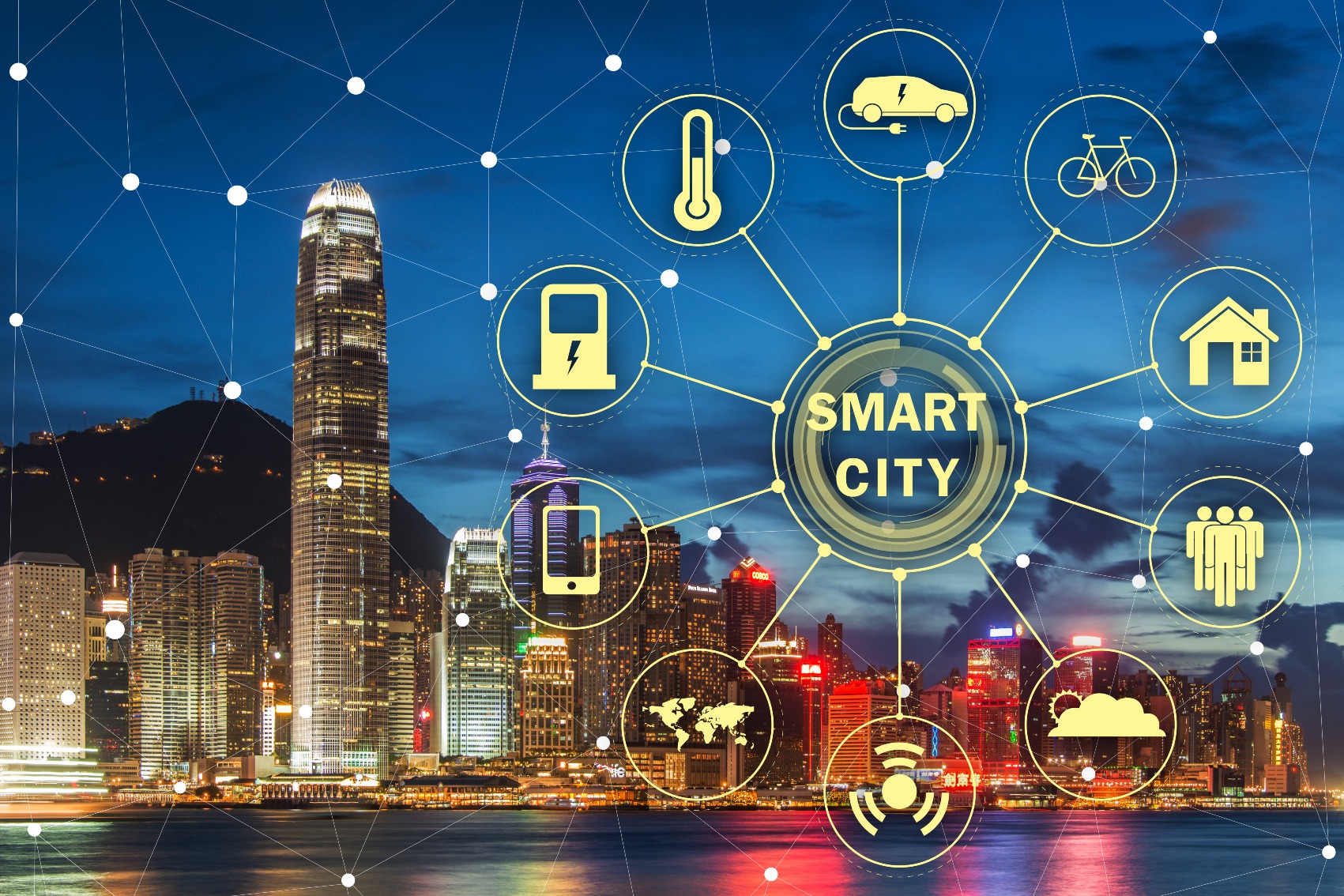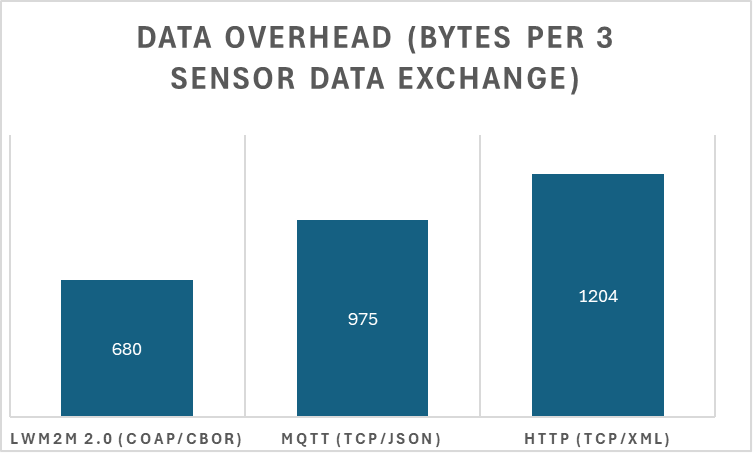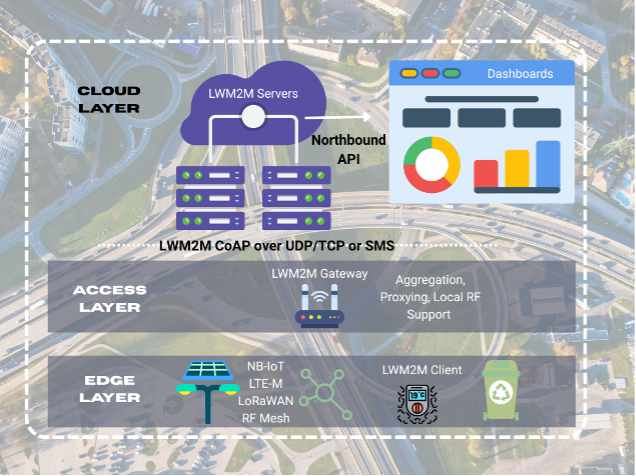
The Role of LwM2M 2.0 in Smart Cities:
From Street Lighting to Waste Management
By:
OMA
|
2025-October-9
The upcoming release of the LwM2M 2.0 specification promises to be a transformative force for the Smart Cities sector, delivering solutions that optimize device management, interoperability, and operational efficiency across critical urban infrastructure—including transportation and traffic management, facilities management, street lighting, environmental monitoring, and waste management systems.
Citywide Management with Minimal Data Costs
Efficient Data Transmission
LwM2M 2.0 is tailored for large-scale deployments of low-power devices, such as smart streetlights, that must communicate and be managed efficiently over often-costly cellular and wireless networks. LwM2M 2.0 lightweight architecture leverages CBOR (Concise Binary Object Representation) and CoAP (Constrained Application Protocol) to shrink payloads between 30%-40% compared to MQTT, ideal for NB-IoT, LTE-M or LoRaWAN networks in smart cities, reducing both operational costs and network congestion while enabling mass deployments without prohibitive bandwidth requirements. This is especially critical where thousands of city-operated devices must transmit status, configuration, and sensor data.
 Figure 1: LWM2M Payload Efficiency
Figure 1: LWM2M Payload Efficiency
Predictive Fault Detection and Remote Monitoring
Remote Monitoring and Diagnostics
Smart Cities depend on real-time status and predictive analytics to pre-empt faults and optimize maintenance schedules from afar. LwM2M 2.0 supports detailed telemetry and diagnostics, enabling remote monitoring for everything from lamp outages in streetlights to connectivity failures in sensor networks. Integration of predictive analytics with LwM2M data streams allows urban operators to forecast maintenance needs, reducing costly downtime and shifting from reactive repairs to proactive interventions. These improvements also help extend asset lifetimes across city infrastructure.
An example of LwM2M 2.0’s Device Object (ID 3) provides telemetry like battery levels and signal strength, while uCIFI’s Lighting Object (ID 3440) reports lamp outages. Northbound APIs feed these into cloud platforms like Azure or AWS IoT or directly, enabling predictive models to forecast maintenance for thousands of streetlights, reducing downtime by 20-30%.
Multi-Vendor Interoperability Across Urban Infrastructure
Vendor-Neutral Interoperability
One of the most compelling benefits of LwM2M 2.0 is its support for standard, open data models—such as those from the uCIFI initiative, now part of the Open Mobile Alliance working group for Smart Cities.
LwM2M 2.0 integrates uCIFI objects like Lighting (ID 3440), Air Quality (ID 3442), and Waste Management (ID 3444), ensuring devices from vendors like Philips or Itron interoperate seamlessly. OMA’s LwM2M Registry defines these reusable models, enabling plug-and-play deployment in smart city platforms.
This ensures that devices from different vendors—whether for streetlights, air quality sensors, or waste bins—can operate seamlessly within a unified city management platform, sidestepping the costly pitfalls of vendor lock-in. True plug-and-play interoperability lets cities deploy new technologies and services flexibly, scaling infrastructure as needs evolve.
 Figure 2: LWM2M High-Level Architecture for Smart Cities
Figure 2: LWM2M High-Level Architecture for Smart Cities
Energy Optimization and Urban Safety
Dynamic Lighting Control
LwM2M 2.0 enables intelligent lighting control schemes that can dynamically adjust streetlight brightness based on ambient light, pedestrian flow, or scheduled events, optimizing energy usage and enhancing public safety. By leveraging citywide sensor input, these systems can lower environmental impact through energy savings, while supporting safety initiatives—such as instant adjustments to lighting in high-risk zones in response to emergencies or peaks in activity. Such dynamic, responsive control is only feasible when secure, low-latency communication and management cover all deployed assets.
An example of LwM2M 2.0 uses CoAP Write operations to adjust uCIFI Lighting Object’s Dimming Level (ID 3440/0/5) based on ambient light or pedestrian sensors, secured by DTLS 1.3 or OSCORE. This enables real-time brightness control for energy savings (up to 40% in trials) and safety in high-risk zones.
For secure control, LwM2M 2.0 supports OSCORE (Object Security for Constrained RESTful Environments), protecting CoAP messages end-to-end through untrusted proxies, using AEAD algorithms like AES-CCM-16-64-128. This complements DTLS 1.3, ensuring low-latency, tamper-proof commands for urban safety and critical infrastructure.
Extending to Air Quality, Noise, and Waste Management
Scalable Sensor Management
The standardization and scalability of LwM2M 2.0 stretch well beyond streetlights, encompassing connected sensors for air quality, noise monitoring, and smart waste management. Devices that track particulate pollution, environmental noise, or fill levels in waste bins can all leverage LwM2M 2.0’s remote management and efficient communications, enabling city operators to react quickly to problems and optimize services across diverse public domains. This leads to healthier, more pleasant urban environments where operations are continuously improved through actionable, real-time insights.
An example LwM2M 2.0 manages sensors via uCIFI objects like Air Quality (ID 3442) for PM2.5/PM10 levels and Waste Management (ID 3444) for bin fill status. Group operations enable firmware updates across thousands of sensors, ensuring real-time insights for healthier urban environments.
OMA is enabling smarter cities
Open Standards for Smart Cities
By enabling efficient, interoperable, and secure device management, the LwM2M 2.0 specification empowers Smart Cities to lower costs, boost sustainability, and enhance citizen well-being across a full spectrum of infrastructure needs—from lighting and safety to air quality, noise, and waste management. The Open Mobile Alliance’s continued commitment to open standards and global interoperability underpins a smarter, safer, and more sustainable urban future.
Bratislava, Slovakia: Signify's LED streetlights reduced CO2 by 672 tons annually, with Interact enabling fault detection - potentially via uCIFI and LwM2M - compatible protocols for scalability.
Paris, France (280K streetlights): Itron retrofitted the city's IPv6-based LED streetlights using IEEE 802.15.4g wireless RF mesh networking. LwM2M facilitates device registration, telemetry (e.g., energy usage, faults), and remote management, supporting Paris's smart city goals for energy efficiency and public safety. This deployment integrates with broader urban sensors for traffic and environmental monitoring.
If you would like to learn more about OMA and LwM2M 2.0? Get our free whitepaper here.
OMA will be exhibiting at the Smart City Expo World Congress, taking place on November 4–6, 2025, in Barcelona. You can find us at Hall 2, Booth F70, where we will be showcasing the next phase of OMA’s commitment to interoperability in smart cities.
Reference Links:
- uCIFI and OMA: Driving Open IoT Standards: https://www.openmobilealliance.org/solutions/smart_cities/
- OMA Resources for LWM2M:https://www.openmobilealliance.org/specifications/resources
- OMA LWM2M Open Source Implementations:https://www.openmobilealliance.org/specifications/resources/implementations

